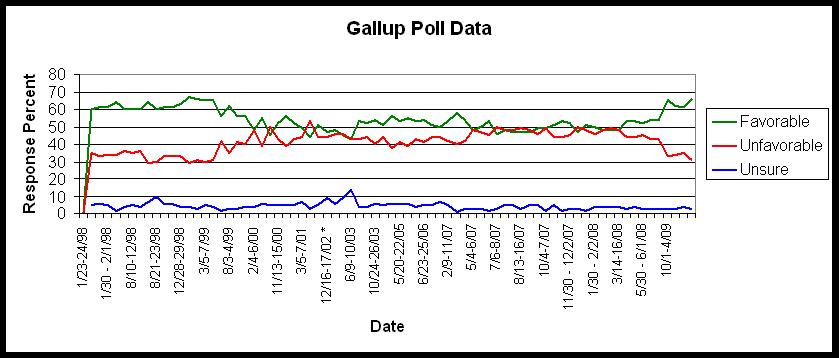First France. Now Canada. The “draft Hillary” campaign that I am now accused of sparking is apparently gaining traction in all the places where no one can vote for her. Evidently that’s the kind of influence I have – a pariah at home, prophet abroad. Yesterday, I appeared on the Arlene Bynon Show, a Toronto-based radio talk show, to discuss the “growing draft Hillary movement”. (Note that the audio link is listed under Monday, August 16. Must be based on the Canadian calendar!) In that interview, she asked a very interesting question: what would it take to persuade Hillary to jump into the race? I should begin by reminding everyone that I don’t think that she will get into the race, nor am I personally advocating a Clinton challenge. (For those who haven’t figured it out yet, I’m an analyst, not a partisan advocate.) The original post that started all this was based on conversations with Democrats, many of whom were making the argument that she should run. In that post I tried to lay out the scenario that would justify that decision. The primary one, as I discussed with Bynon, is the calculation that Obama can’t win in 2012, and that she would have a better chance of keeping the White House in Democrat’s hands. We can (and have) debated whether that is true.
But Bynon’s question got me thinking: what would be the logistical hurdles a Clinton challenge must overcome? In contemplating this question, it becomes immediately clear that she faces complications that previous intra-party challengers to incumbent presidents did not. To begin, she is part of Obama’s administration. When Ted Kennedy challenged Jimmy Carter in 1980, he was a sitting Senator and sometime administration critic. Four years earlier, Ronald Reagan was an ex-Governor with national stature but no official public position when he took on the “accidental president” Gerald Ford. In 1992, Pat Buchanan was a media personality with a reputation for “pitchfork” American-first politics at odds with President George H. W. Bush’s more internationalist “new world order” foreign policy. If we go back further, to 1968, both Eugene McCarthy and Robert Kennedy were senators who turned against the Vietnam War when they launched their bids for the presidency held by Lyndon Johnson.
As Secretary of State, Clinton faces a different challenge. Presumably launching a candidacy would involve a two-step process – resigning from Obama’s administration and announcing she was taking him on. Taking the first step would generate immediate speculation about the second, so she would in all likelihood combine them both into a single media bombshell announcement. “I am stepping down today to announce…” In that speech she would have to explain why, as a member of the Obama team, loyalty demanded that she not express the deep dissatisfaction that was now fueling her run. Could she pull off this delicate political pivot? Jon Huntsman has had to perform a similar two-step, with results still pending. If Clinton is truly committed to running, I don’t think this additional complication would be an impediment to winning, although some opponents would certainly cite it as a form of political “backstabbing.” But my guess is it wouldn’t cost her the votes of people who would otherwise be inclined to support her.
One reader laid out another factor that might be necessary for Clinton to run: a Democratic stalking horse. If another Democrat launched a bid against Obama – say a Kucinich, or Feingold – that might provide political cover for Clinton to jump in. A similar dynamic drove RFK’s decision in 1968; he formally entered only after McCarthy’s second-place finish to LBJ in the NH primary demonstrated that the President was vulnerable.
There is also the timing issue. When would Clinton have to announce? Reagan, Kennedy and Buchanan all launched their bids about a year before the general election: Reagan in November 1975, Kennedy in November, 1979 and Buchanan in December, 1991. That gave them 10-15 weeks to gear up for the New Hampshire primary. In contrast, under the pre-primary, convention-dominated nomination process, Robert Kennedy could afford to wait much longer before entering the 1968 race, since he was courting party leaders who controlled blocs of delegates more than issue activists that voted in primaries. Given the front-loading of the current nomination process, and the need to put together a funding infrastructure, I would guess Clinton would have to declare at least as early as did Reagan, Ted Kennedy or Buchanan – that is, no later than December, 2011.
So, what would it take for Clinton to run? Here’s the hypothetical scenario. Sometime in the next two months, a progressive Democrat needs to jump into the race, perhaps emboldened by a drop in Obama’s approval ratings into the mid-30% level. Meanwhile, despite the President’s nationwide September “jobs” speech, third-quarter employment figures come back showing little-to-no job growth. Then the joint budget committee releases a deficit reduction plan that calls for deep spending cuts, including entitlement reform based in part on pushing back eligibility dates which are interpreted by the Democratic Left as de facto benefit cuts. Meanwhile, Syria and Libya continue to burn, while a rise in violence in Iraq leads the government there to petition for an extension of the U.S. military presence. These events don’t need to unfold exactly like this, or in this exact sequence, but you get the picture.
Would this convince Clinton to throw her pantsuit into the ring? I doubt it. But evidently what I think no longer matters (if it ever did) – the “Draft Hillary” movement has gone international! Will the U.S. be next? Stay tuned, and keep those comments coming.
(Note to Readers: I’m on deadline with a couple of papers, so will be posting shorter pieces in the next couple of weeks.)


